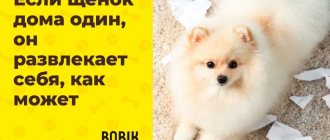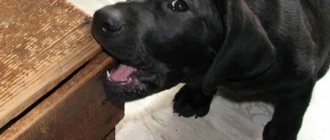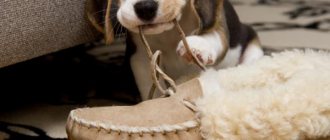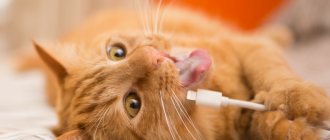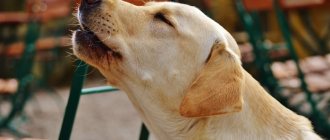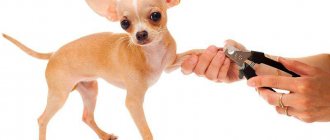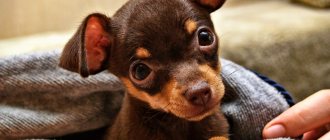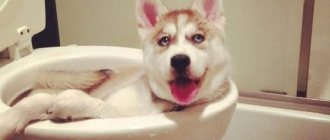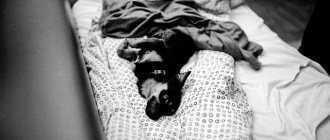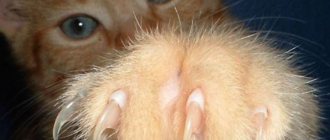On YouTube this video is called “Idiot dog”. Is the poor dog suffering from duality, or not from disorder? personality, after all, she fights with her own legs! She has a bone, and she fanatically protects it from the attacks of her front and hind paws. It seems that the dog would also anathematize his right front - but he needs it, he will have to take it as an accomplice, without it there is no way to gnaw the bone. At first the left front gets it, but then the dog notices that the back part is reaching for the personal property with its sneaky paw! And then the rear right one gets it - because there’s no point in climbing into where the front part of the dog is gnawing on the extracted bone. The dog frantically bites his back leg, freezes for a moment in shock that he bit himself, but then, after thinking a little, continues to restore justice. And what? It’s not for nothing that they showed in that cartoon that every dog has a cat at the end! And why am I going to feed him my hard-earned, dear bone! We are not tolerant Cotops here, but real Labradors, so we are not going to share bones!
OPINION OF A CINEMATER
Why does a dog fight with its leg - the opinion of a dog handler?
At first glance, it may seem that the dog has “gone crazy.” Let's try to analyze what made the dog behave so strangely. You can immediately identify two forms of behavior that appear in a dog at the same time. First, the dog eats and, as a result, intends to guard the food. Moreover, it is in this dog that possessive reactions are quite developed. Secondly, the dog’s scratching reflex is triggered. The result is the following. As soon as the dog received the bone, the dog immediately developed a strong sense of ownership. After all, bone is food, and in a pack of dogs there will always be many hunters for other people's property. Moreover, if the challenger dog is much higher in status than the owner dog, then, theoretically, this dog, the dominant challenger, can force the owner of the bone to concede through a threat and a demonstration of strength. But with an equal in status, but impudent applicant, the dog owner will not stand on ceremony. Just the second of the mentioned types of behavior is seen by the dog in the movements of its own hind paw, carefully reaching towards the ear, which itches. Against the background of strong possessive reactions, the dog develops the image of an impudent but cautious contender for the bone, who needs to be scared away and intimidated, to impress with his rage. Therefore, as soon as the dog sees a sneaking “enemy” out of the corner of its eye, it first growls “brutally”, squinting its eyes at the “enemy”, then the dog makes threatening attacks, and even bites the “encroacher”, achieving the desired effect. In this case, the dog may become quite painful, which causes inhibition of the scratching reflex. And so, as soon as it seems to the dog that the “enemy” has retreated, it enthusiastically returns to its prey.
SCIENCE'S OPINION
Scratch reflex in a dog.
Let us consider such an elementary unconditioned reflex in a dog as scratching, in which it would seem easier to isolate a specific
The triggering factor is tactile in nature. It turns out that this form of dog behavior is triggered by a whole set of stimuli, which includes at least tactile, vestibular, iroprioceptive, and visual. All of them constitute the afferent support for this behavioral act of the dog. Maybe the executive part is more local? It turns out that it certainly begins with the inhibition of current activity (Ukhtomsky, 1966) and the active restructuring of the dog’s posture, then the rhythmic movement of the dog’s limb is started, and only in the end is contact of the limb with the surface of the dog’s skin achieved (or not). Let's not forget about the vegetative support of such a behavioral act of the dog. Naturally, in this case it is simply impossible to think about any single central link that ensures the switching of multimodal afferentation to the poly-effector apparatuses of a given behavioral act of a dog. Then where is the “center” of this reflex located (according to the classical concept) and what acts as its reflex arc? A. A. Ukhtomsky answers this question this way: “We should probably talk not about once and for all organized somato-vegetative mechanisms in the cortex, but about constantly organizing combinations of events in the somatic and vegetative areas over time. Depending on the receptive stimuli of reactions and on the degree of urgency of the extero- and interoceptive demand, either the vegetative or the somatic component will predominate.” To perform an “unconditioned reflex” in a dog (for example, scratching), a number of conditions are required, and first of all, the achievement of a certain (temporary) the functional state of the dog’s system of brain structures (constellation, but to Ukhtomsky), which determines the involvement in it of all the central links of a specific behavioral act of the dog.
Based on materials from the book by A.S. Batuev
“Physiology of VNI and sensory systems”
Sometimes it happens that a four-legged friend begins to actively gnaw at his own paws, as if he were itching or trying to bite out a splinter. We need to figure out how to help her stop doing this.
Most common reasons
Most often, a dog begins to actively chew its paws when it is bothered by a splinter or. Everyone knows that dogs have the habit of licking wounds, and when they are in hard-to-reach places (on the pads of their paws), the dog tries to bite the fur for convenience. Check the paws for injuries and, if necessary, provide medical attention to the dog.
Another common cause is claws that are too long. If they cause discomfort to your four-legged friend, he will constantly try to shorten them on his own by gnawing with his teeth. Do not forget to monitor the optimal length of the claws; you not only need to take care of the correct length of hair on the paws.
If your dog chews its paws only in winter, most likely, in this way it removes frozen pieces of snow and ice that interfere with walking, or simply your dog puts itself in order by removing foreign objects. This is quite normal and you should not scold the animal for this.
Health problems
It is possible that this dog behavior may also be caused by health problems. For example, the reason that an animal chews its paws may be the presence of a fungal infection that causes itching. Either it is a lack of vitamins or excessive dryness of the paw pads (for example, due to the constant contact of a street reagent on the pads), which also greatly worries the animal.
There is also a risk that the dog has been bitten on the paw by a tick and is trying to get it out with its teeth. Be sure to examine the animal after walks in the warm season - a tick bite can be dangerous due to its development, which can be fatal without treatment.
Do not forget that dogs are in many ways similar to people and can also have bad habits. Observe your four-legged friend: if he chews his paws only when alone or after receiving punishment, then it is likely that in this way the dog is trying to relieve his stress.
In people, nail biting is considered a bad habit that is mental in nature and requires correction. Usually, for this it is recommended to visit a psychologist, who will find out the roots of the problem. But why a dog bites its claws, and what this behavior may be associated with, few people know, except perhaps veterinarians. Indeed, should the owner worry if his four-legged pet begins to regularly damage his own claws? And when can you not do without professional help?
It’s not for nothing that dogs are called man’s best friends - they don’t just live side by side with people, save them from loneliness, make them happy, and serve faithfully. These pets literally adopt human habits; they can experience joy, discomfort, melancholy or anxiety. And if the dog suddenly begins to bite its claws, it is worth observing its behavior. Perhaps this is an alarm bell - a sign of malaise or suffering from loneliness.
First of all, it is necessary to exclude the presence of damage on the nail plates and around them - kinks, cracks, burrs. All fingers on the pet's forelimbs should be examined. Dogs often find themselves fond of digging; during this process they may stumble upon roots, sticks, stones and other hard objects that may be in the soil.
Typically, dogs digging the ground enjoy it and, in their euphoria, may not notice any discomfort. If your pet starts biting its claws after a walk, you need to do the following:
- thoroughly rinse the animal's paws with warm water
- dirt that sticks to the skin and nails often causes irritation; - you should check that the claws have not outgrown their normal length
- in most purebred representatives, in normal condition they should not touch the floor surface in a standing position; - It is recommended to inspect the nail plate for damage
- cracks and burrs. In dogs, the upper layer of the claw plate is periodically replaced, and if the keratinized area has already begun to recede, but has not yet separated, after digging or active walking, burrs may appear, clinging and interfering with the four-legged friend; - It is advisable to assess the condition of the dog’s paw pads
- whether there are any wounds, cracks, abrasions or burns on their surface. It is worth noting that damage can occur when the skin of the paws comes into contact with snow, hot asphalt, or reagents.
How can you help your pet if any damage was discovered during examination? If the pet does not resist and calmly tolerates hygiene procedures, in most cases the problem can be solved on its own.
It should be borne in mind that a damaged claw can heal/fall off without external intervention, but before that it will cause severe discomfort and even pain to the pet. In addition, if the crack has affected the nail canal, there is a risk of bleeding if it is accidentally broken. And the wound will serve as a gateway for various kinds of pathogenic infections that cause the development of the inflammatory process and serious diseases. In this case, it will not be possible to avoid long-term, serious therapy.
First aid
First, you should carefully examine the paws of your ward. Pets often flirt when they dig the ground. There are fragments, hard roots, and debris in the soil. Due to a good mood, the pet does not immediately react to pain.
Wash your paws. Use water at room temperature. This is necessary to remove dirt. Estimate the length of the claws. If they are too long, your pet will begin to do his own “manicure.” Normally, in most breeds, the claws should not touch the floor.
Dogs' "nails" are renewed gradually. The top layer is removed regularly. If it has already become keratinized, but has not come off completely, the animal may accidentally undermine the keratinized part during play. As a result, hangnails appear that cling and interfere. They must be carefully removed.
Pay special attention to your fingertips. Are there any damages on them? Even if there are no visible wounds on the skin, there may be burns from heated asphalt or sand, or from chemicals that are sprinkled on the road in winter.
If you find a minor injury, you can handle it yourself. Rinse the wound regularly with diluted hydrogen peroxide or potassium permanganate. It is unacceptable for iodine or brilliant green to come into contact with damaged tissue: this can cause a burn. Do not allow your pet to lick its paws, as there is a high risk of infection.
Torn, cracked and broken claws are very treacherous. It seems that the injury is insignificant, when in reality such wounds heal with difficulty and often become infected. If the “nail” is damaged, it is better to consult a veterinarian. He will assess the severity and trim the claw if necessary.
Preventive measures - against diseases and injuries to claws
Preventing the disease is a simple task if you pay due attention to it. Experienced dog breeders have an established system that helps them maintain the health of their four-legged friend. First of all, we are talking about the daily routine and mandatory procedures that a pet is accustomed to from puppyhood:
- Nail trimming
. Sooner or later, all animals require this event, including those leading an active lifestyle - those who work and spend a lot of time on the training ground. Even if the dog’s claws wear down naturally, additional trimming may be necessary in the winter, when the pet is forced to rest, during the bitch’s pregnancy and other situations when the animal’s activity decreases. The guillotine nail cutter should be used as soon as the plates begin to reach the ground. It is advisable to entrust the first procedure to a professional - he will tell you the acceptable limit and show how to cut the claw correctly so as not to damage it. - Washing paws
. The dog's paws should be washed after every walk, regardless of weather conditions. It is better to do this with cool or lukewarm water. Sometimes this procedure can be replaced by wiping the limbs with a damp cloth. For an untrained pet, this event can cause anxiety and irritation, especially when it comes to the hind legs. If the dog has not been trained from an early age, you can initially use reward in the form of a treat - this will create a pleasant association in the dog. - If required, you need to take care of shoes for your dog
. Representatives of non-working breeds, whose paw pads are covered with delicate skin, are recommended to wear special boots before walking. They protect your pet’s limbs not only from cold and moisture, but also from the effects of snow, sand, salt, and reagents that get on the claws and feet, causing chemical burns or cold injuries. - Sometimes special care is needed
. Your pet's pads should be inspected after every walk, but in some cases special procedures are not necessary. For example, some dogs in the heat require additional moisturizing of the skin on their paws - at high air temperatures, the animal can develop dehydration, which will also negatively affect the condition of the coat, skin and claws. For these purposes, you can use cosmetic Vaseline, baby cream or milk, which soften the tissue, thereby reducing the risk of possible cracking of the surface. - Proper, balanced nutrition
. As you know, if a dog is poorly fed, its coat becomes dull and sparse, and its nails begin to flake and break. It is important that your pet’s diet consists of healthy, fresh foods, and when feeding ready-made food, you should choose a high-quality premium or super-premium product.
Bites claws when stressed
Such behavior is not always caused by illness and physical discomfort. It is often due to the fact that the dog experiences stress - after a fright, during longing for the owner, when changing place of residence and other situations that knock the pet out of its usual rut. Puppies are more active than their adult counterparts and require regular exercise. But although older dogs are more balanced, they can also become bored.
If a pet does not receive proper attention, does not have the opportunity to throw out excess energy, and rarely goes outside, then it is susceptible to the development of a mental disorder, obsessive neurosis - compulsive syndrome. If a puppy begins to bite its claws out of boredom, later the older dog may resume this habit. The pet can do this during times of stress, fear and other experiences, finding calm in the activity.
A healthy, adult dog, having seen off the household, goes to have a meal and lies down to rest. But against the background of compulsive disorder, the animal, when alone, shows anxiety. The pet can gnaw its claws, chew or frantically lick its own limbs - the fur on them is constantly wet, sparse, bald spots and irritations appear.
In addition to mental disorders, the disorder causes a number of quite tangible physical illnesses. Damaged nail plates, wounded skin on the fingers - all this is accompanied by severe pain, due to which the dog is unable to concentrate, does not listen, or even loses interest in walking.
Often dogs unintentionally injure their limbs by catching them with their teeth. In this case, discomfort and pain are not the main problem. Pathogenic bacteria penetrate open wounds.
Most often, the forelimbs of pets are affected by lick granuloma. With this disease, the damaged area turns red, but in a short period it turns into an open, large wound. And if the dog continues to lick the limb, the muscle tissue begins to die until the bone is exposed. This pathology requires proper treatment; the veterinarian prescribes drugs for topical application and agents with a calming effect.
Experts warn that psychological disorders require complex therapy, that is, no matter how much you treat a dog’s damaged paw, it will continue to experience stress, lick and chew the limb, aggravating its own condition.
Possible causes of self-chewing
The reasons why a dog chews itself are mainly itching or pain of various origins, and below we will look at the most likely of them. However, in any case, the cause of discomfort and ways to solve the problem must be determined by a veterinarian.
Inflammation of the claw bed (felon)
Panaritium occurs due to injury to the base of the claw, for example, if the pet’s claws are not trimmed in a timely manner and he often catches on them when walking up the steps. Inflammation gradually develops, pathogenic microflora joins and causes suppuration.
Advanced felon in a dog
Swelling becomes noticeable, and the claw may soften. The pet begins to limp, often licks or bites the sore limb at the site of inflammation.
To prevent such a process, your pet needs to trim its claws in a timely manner and inspect its paws after a walk for injuries.
Inflammation of the paraanal glands
Inflammation of the paraanal glands occurs due to a violation of the outflow of secretion and their overflow (for example, due to poor hygiene, injury, poor nutrition), resulting in stagnation of secretory fluid and inflammation. In the future, with the participation of pathogenic microorganisms, a purulent process may occur, which often leads to the formation of a fistula.
When the anal glands are blocked and overfilled, as a rule, the animal experiences itching, which it tries in every possible way to get rid of. It may rub its butt against some surface, lick or, as it were, bite out fleas under its tail.
Cleaning the dog's anal glands
To prevent this disease, it is necessary to maintain pet hygiene, take care of a balanced diet for it and frequent walking. Also, if necessary, clean the paraanal glands (by contacting a veterinarian).
Allergy
An allergic reaction occurs in response to some exposure to an allergen from the outside or its entry into the body. Moreover, sometimes the body perceives completely harmless things as an allergen - this happens due to a malfunction in the immune system.
Allergies can manifest themselves as redness of the skin, swelling, itching, rash and other phenomena that cause discomfort and anxiety in the dog.
Manifestations of food allergies in dogs (video)
It is customary to distinguish several types of allergies depending on the causes that cause them:
- Food allergies are the most common type and most often occur to proteins, artificial additives or dyes. Accompanied by skin rash, itching, hair loss, and dandruff may appear. Food allergies can also cause vomiting and/or diarrhea.
- Atopic dermatitis is caused by an increased reaction to allergens (for example, pollen, dust, household chemicals, dog cosmetics, parasite waste products). As a rule, such an immune reaction is genetically determined and can be inherited. This allergy manifests itself as itching, redness and thickening of the skin, rashes, and hair loss.
- Drug dermatitis is provoked by the introduction of drugs orally or by applying them to the skin if the animal is intolerant to the substances that make up these drugs. The allergy is manifested by skin redness and itching, swelling of the mucous membranes, sometimes intestinal upset and suffocation.
- Reaction to bites of stinging and blood-sucking insects. An allergic reaction is caused by insect saliva or venom. It manifests itself as redness of the skin at the site of the bite, itching, and the formation of crusts.
- Contact dermatitis occurs in response to a physical or chemical irritant, such as a burn, frostbite or exposure to a salt reagent in winter; hairless dogs can develop solar dermatitis - a reaction of unprotected skin to exposure to direct sunlight. Accompanied by itching, rash, redness of the skin, in severe cases blisters, eczema.
If you suspect an allergic reaction in your pet, then it is necessary to identify its cause as quickly as possible, immediately stop the animal’s contact with the allergen and prevent it in the future. It is also necessary to take antihistamines and other symptomatic treatment, for which you need to immediately consult a veterinarian.
Infectious dermatitis (fungal and bacterial)
The disease occurs when opportunistic bacteria and fungi (normally present on the skin) multiply excessively. This happens due to a decrease in the animal’s immunity. Infectious dermatitis manifests itself as itching, pain, swelling, peeling; bacterial dermatitis is additionally manifested by redness, increased local temperature, and the release of exudate (effusion).
Infectious dermatitis. Photo: Melinda's Mission
If there are violations of the integrity of the skin, pyoderma may develop, an infectious skin disease that affects the deeper layers of the skin. It manifests itself in the formation of papules or pustules on the skin (resembling human acne), severe itching, hair loss, and peeling.
For the prevention of infectious diseases of any origin, the most important factor is the animal’s strong immunity. To do this, he needs a balanced diet and sufficient mobility.
Subcutaneous (intradermal) mite
Various types of so-called subcutaneous mites live inside the skin and in the course of their life activities cause severe itching. Also, often with tick-borne infections, an inflammatory process occurs.
The causative agent of canine housemode mange is the microscopic intradermal mite Demodex Canis
Mite infestation manifests itself as severe itching, redness, rash, formation of scales, crusts, hair loss, folding, and swelling of the skin.
Injuries and microtraumas of the extremities
Injuries to the limbs are accompanied by discomfort and pain, sometimes itching (for example, microcracks due to damage to the paws from snow crust), which can provoke the dog to chew on itself.
If you notice an unnatural shape in your pet's limbs, lameness, or difficulty moving, contact your veterinarian immediately for advice. Your dog may have an injury or illness that, if ignored, could have serious consequences.
Metabolic disorders
With vitamin deficiency, dogs develop itching, dandruff, weakness, and a decrease in body temperature.
A lack of minerals may result in perverted appetite, deterioration in coat quality, weakness, and gastrointestinal upset.
Photo: itchy
Such violations are more common in enclosures, crowded housing, and lack of nutrients, micro- and macroelements from food.
A balanced diet and regular walks in the fresh air are extremely important for the normal metabolism and development of your pet.
Neurological problems
As a result of injuries, tumors, intoxication, damage to the spinal cord or brain, loss of sensitivity, most often in the limbs, can occur. Often dogs begin to gnaw on a part of the body that has lost sensitivity and, due to the lack of pain in it, severely injure themselves.
Also, as a result of stress factors against the background of feeding, poor in vitamins and essential elements, auto-aggression can develop - a chronic disease in which the animal chews itself. In this case, dystrophic disorders occur in the brain, as a result, itching, excitement and paresthesia (numbness and tingling sensation) appear in the pelvic area.
Joint pain
Joint diseases are often accompanied by pain and bring a lot of discomfort to the dog. Often in such conditions local swelling develops, accompanied by itching.
With joint diseases, the dog may chew on its limbs. The dog may try to cope with pain and itching in different ways, including by biting.
Aujeszky's disease
Not the most common cause of self-gnawing, but the most dangerous, “false rabies” (the second name for this disease) is caused by a pathogen from the herpes virus family. Characterized by severe itching, refusal to feed, drooling, periods of excitement alternate with periods of depression. A sick animal nervously licks, scratches and chews on parts of its body.
The disease develops very quickly, no more than 1 week passes from the moment of infection to death, so the owner does not always have time to understand that his pet is seriously ill. Treatment for Aujeszky's disease in dogs is ineffective.
Diseases: infectious, fungal and others
Often the dog begins to chew its paws because it is bothered by itching that occurs due to some pathological conditions. Unfortunately, dogs do not have hands, and they have to use their teeth to get rid of itching. Paws may itch due to the following diseases or pathologies:
- allergic reaction;
- severe vitamin deficiency;
- diseases caused by infectious pathogens;
- ailments caused by pathogenic fungi - they affect the nail plate, which begins to delaminate, accompanied by unbearable itching. The claws become lighter in color and may emit a sweetish, nauseating odor;
- symmetrical lupoid or lupus onychodystrophy - a disease that affects representatives of large and giant breeds, is considered an autoimmune disease. As it develops, the nail plates are torn away from the bed.
Nail gnawing is a phenomenon that is unusual for a dog that is not bothered by anything. If she starts doing this, then it’s worth finding out the reason and saving your pet from trouble.
When an owner notices their dog chewing its nails, it can not only be annoying, but also raise questions and concerns. And this is true, because there may be serious and dangerous reasons for the pet’s health for such behavior.
Vadim
Why does a dog bite his toenails? What to do?
One of the fairly common complaints many dog owners have is that their dog bites its nails. Moreover, this applies to almost all breeds - large and small, decorative and service. Since there can be many reasons for this behavior of an animal, it is necessary to consider them all in detail. Some of the reasons that cause a dog to bite its claws can be dangerous to its health and require prompt and quality treatment from a veterinarian.
Reasons why a dog bites its claws
Boredom or stress
Sometimes such an activity has no serious basis. Just like people have a bad habit of biting their nails, a dog may do it just to keep himself occupied. Moving to a new apartment or change of owner may also be a reason.
Untimely haircut or lack thereof
If the rules of care are violated, a haircut is rarely done, or even never at all, it is not surprising that she tries to get rid of them herself. Overgrown claws prevent the animal from walking and negatively affect the paws and spine.
Allergy
It is quite easy to recognize that biting claws and paws is caused by an allergy - the dog begins to do this after a walk. The first thing to do is buy special shoes so that the allergen does not come into contact with the skin and fur.
Dirt
Unlike the previous point, you won’t notice your dog biting its claws after every walk. The method of control is the same - boots, cutting the hair on the paws and washing them regularly. In winter, paws often suffer from the reagents that are sprinkled on the snow.
Fungal infection
With this disease you need to go to the veterinarian. It is quite difficult to recognize it, because it is difficult to see anything on the skin behind the fur, especially if it itches and the dog twitches when examined. However, if you notice red spots and inflammation, take your pet to a specialist.
Cuts, thorns, splinters
Carefully inspect the paw pads and toes. The dog may experience discomfort when touched in a specific area. Often the object causing discomfort is easy to remove on your own. It is also possible for the claw to split, for example, from a blow. It causes pain, but just like with humans, it will go away once it grows back.
Circulatory disorders
Older animals chew their paws more often. This is due to wear and tear of the body, displacement of spinal discs, and pinched nerves. When blood flows poorly to the limbs, they begin to go numb. We know that “prickling” feeling. Dogs experience the same thing.
Damage and wear of joints
When a joint begins to hurt, the pain can be projected elsewhere. A dog can chew not only its claws, but also the paw itself. This should be reported to your veterinarian.
Poor nutrition
Lack or excess of food, lack of vitamins and too much protein lead to some changes in the claws. For example, they may begin to peel off, so the dog gets rid of the disturbing parts. Or an obese dog experiences deformation of its fingers under the pressure of its own weight. The claws also naturally become bent, which interfere with his walking.
What can be done in such a situation
After discovering a problem, every owner wants to know what to do if their dog bites its nails. First of all, it is necessary to eliminate the cause of this behavior, if it is obvious. To do this, you first need to check the length and condition of the claws. In most cases, it is enough to simply trim the nails with a special nail clipper for dogs. At the same time, care must be taken not to shorten them in such a way that a nerve or vessel will be affected. It is enough to trim them at the level of the fingertip. If the edges are too sharp, they need to be carefully filed.
